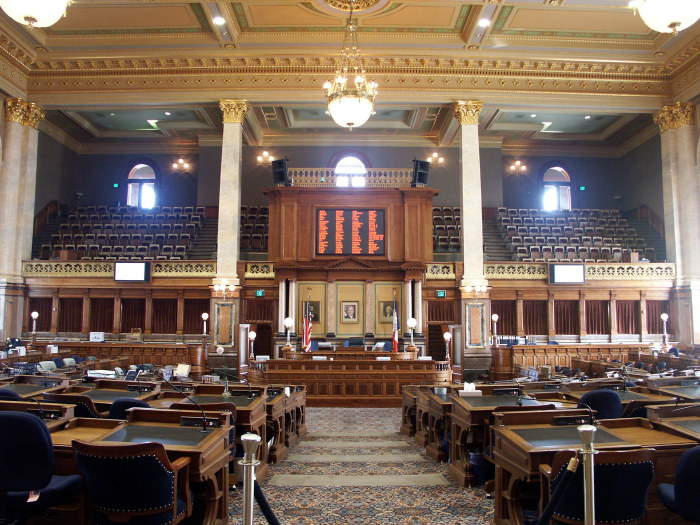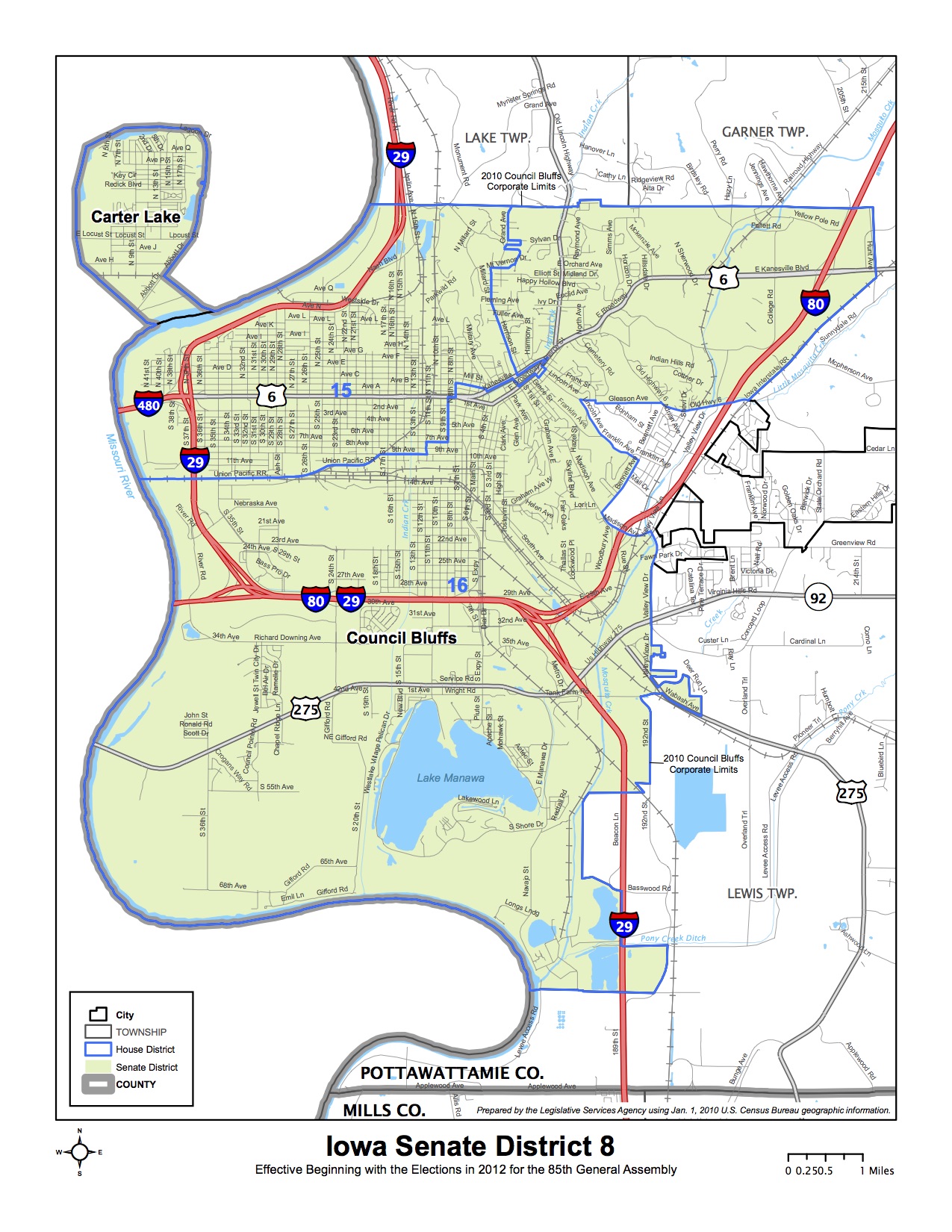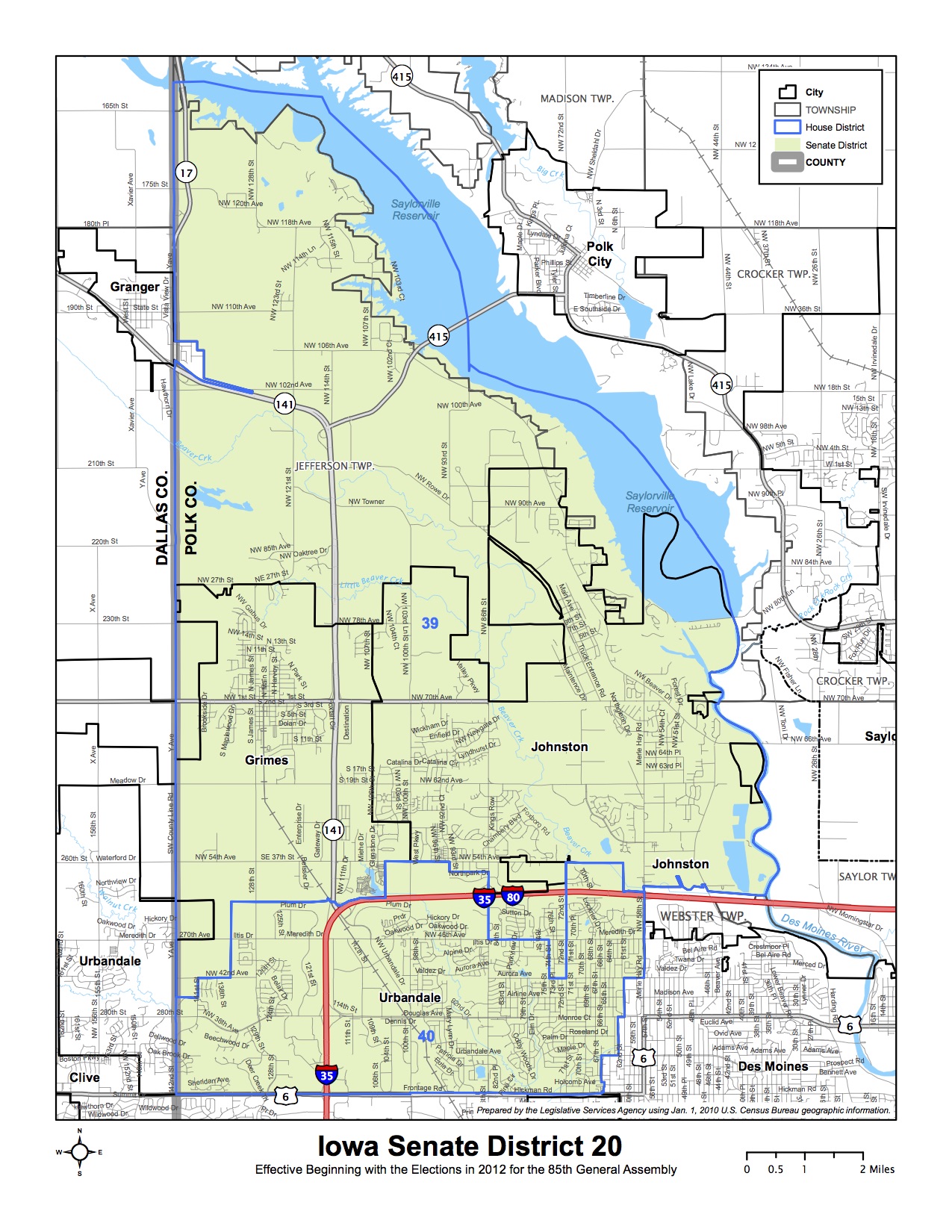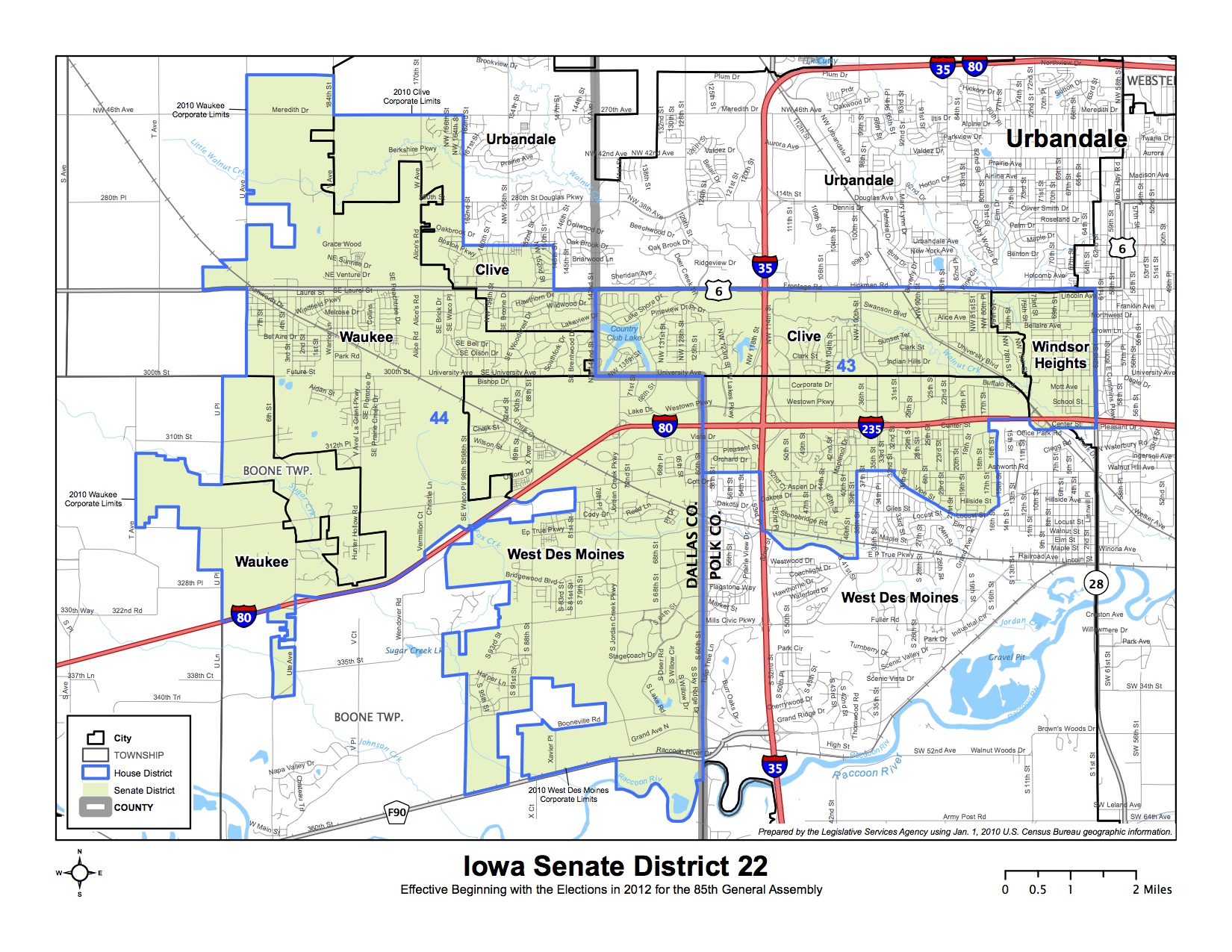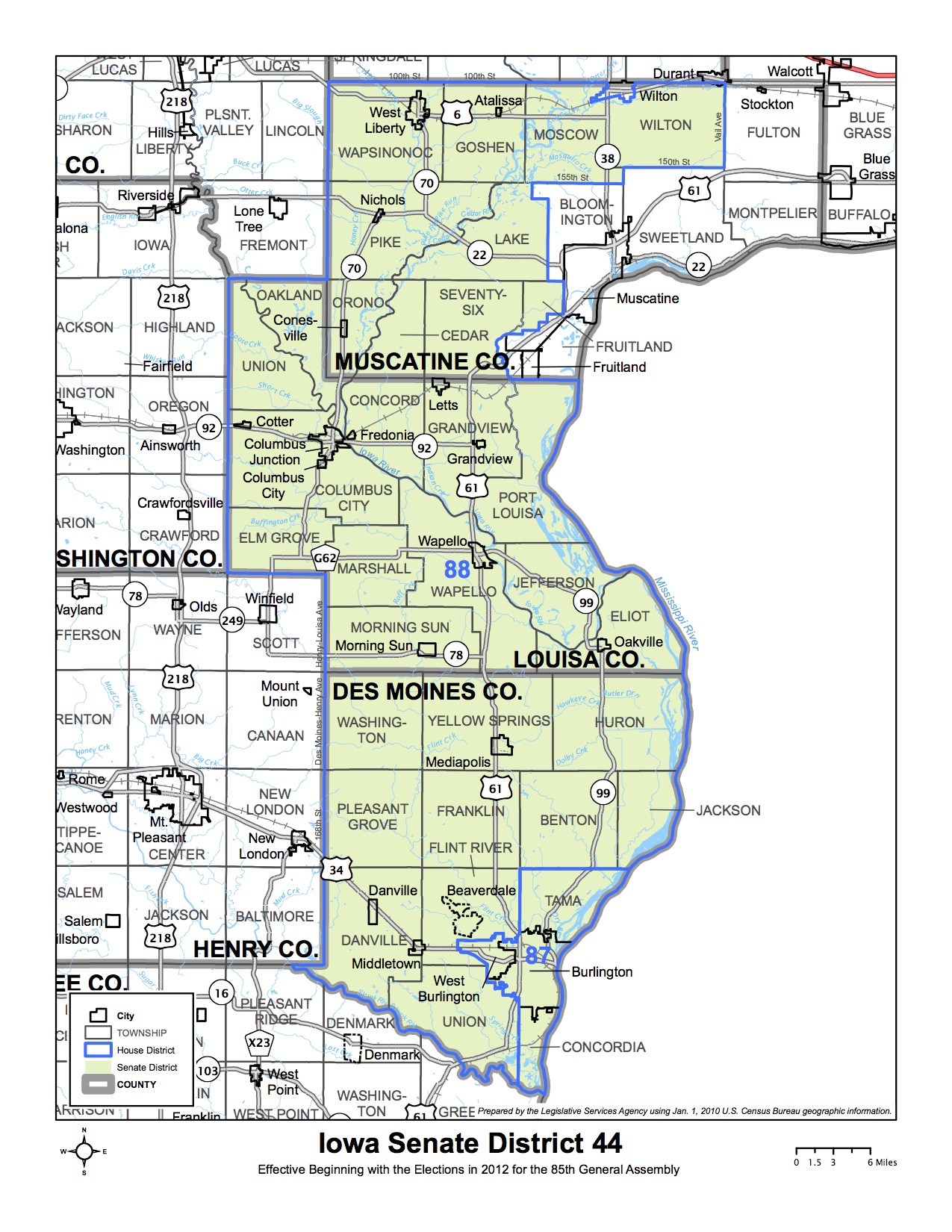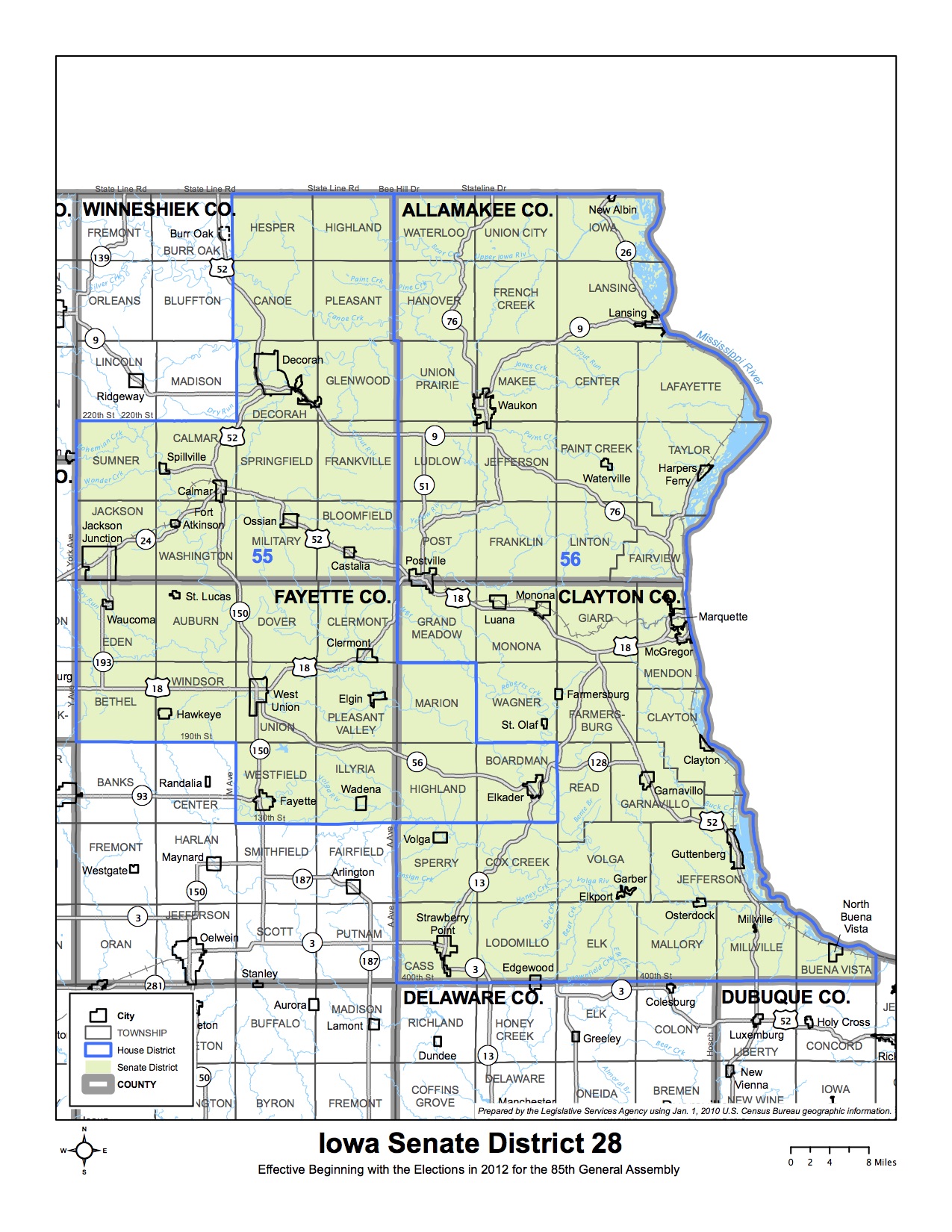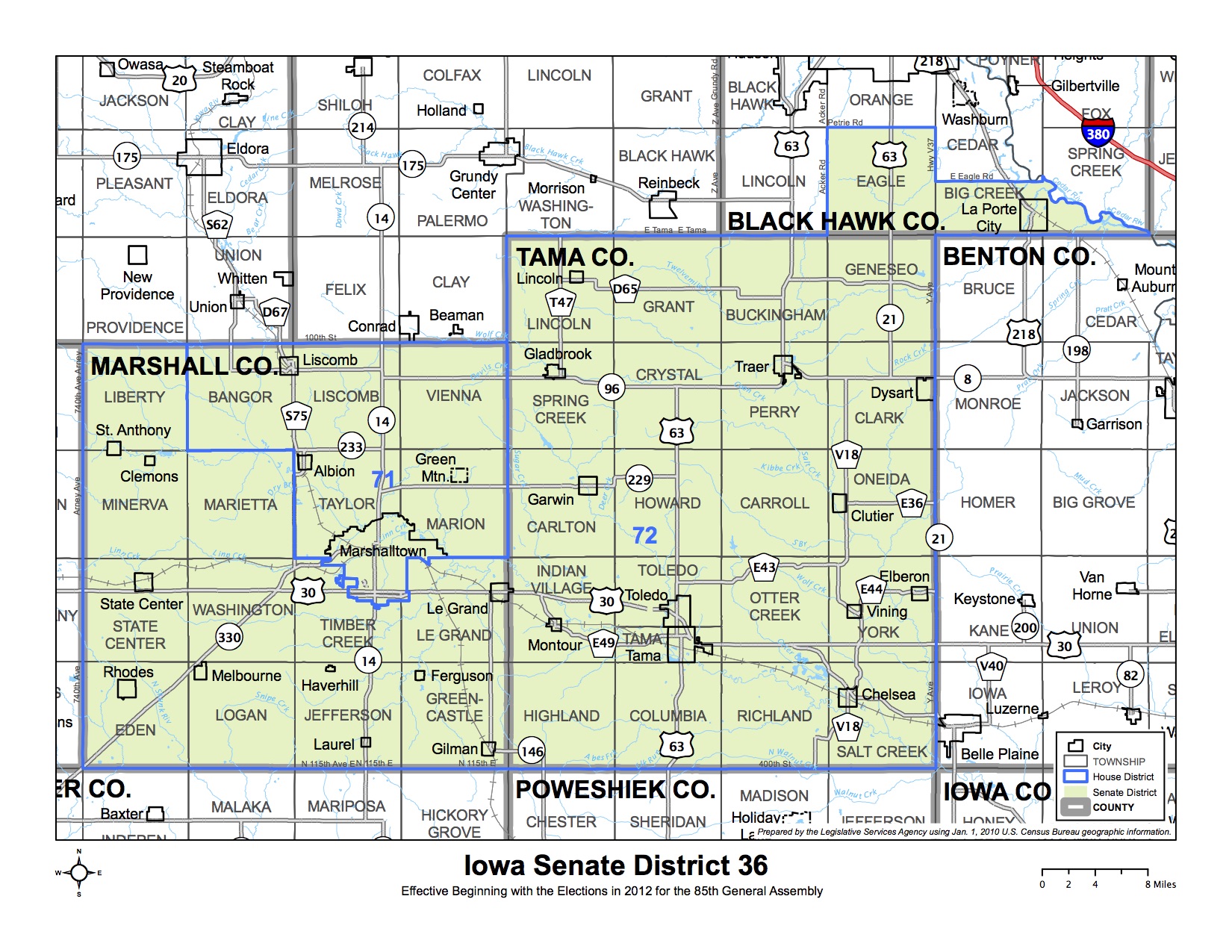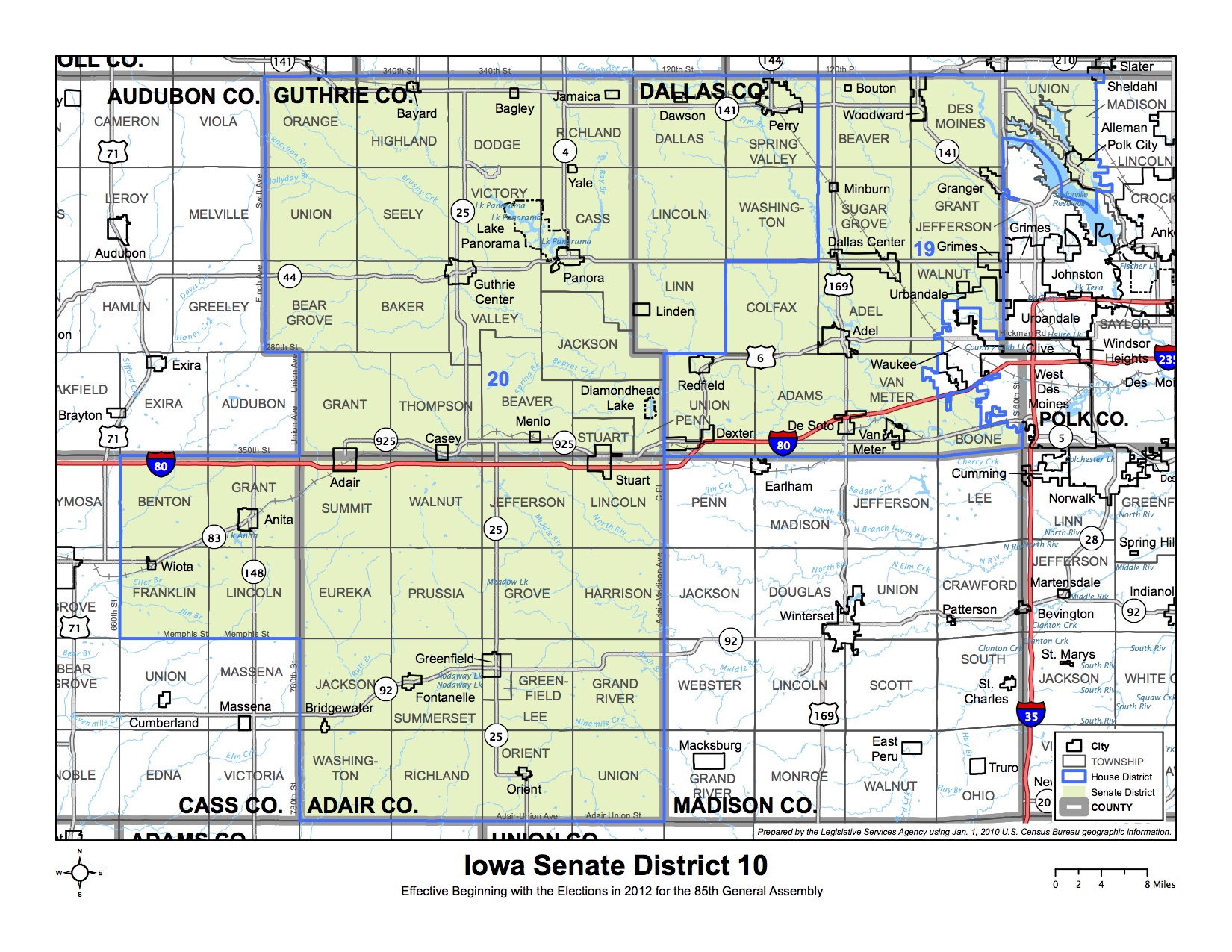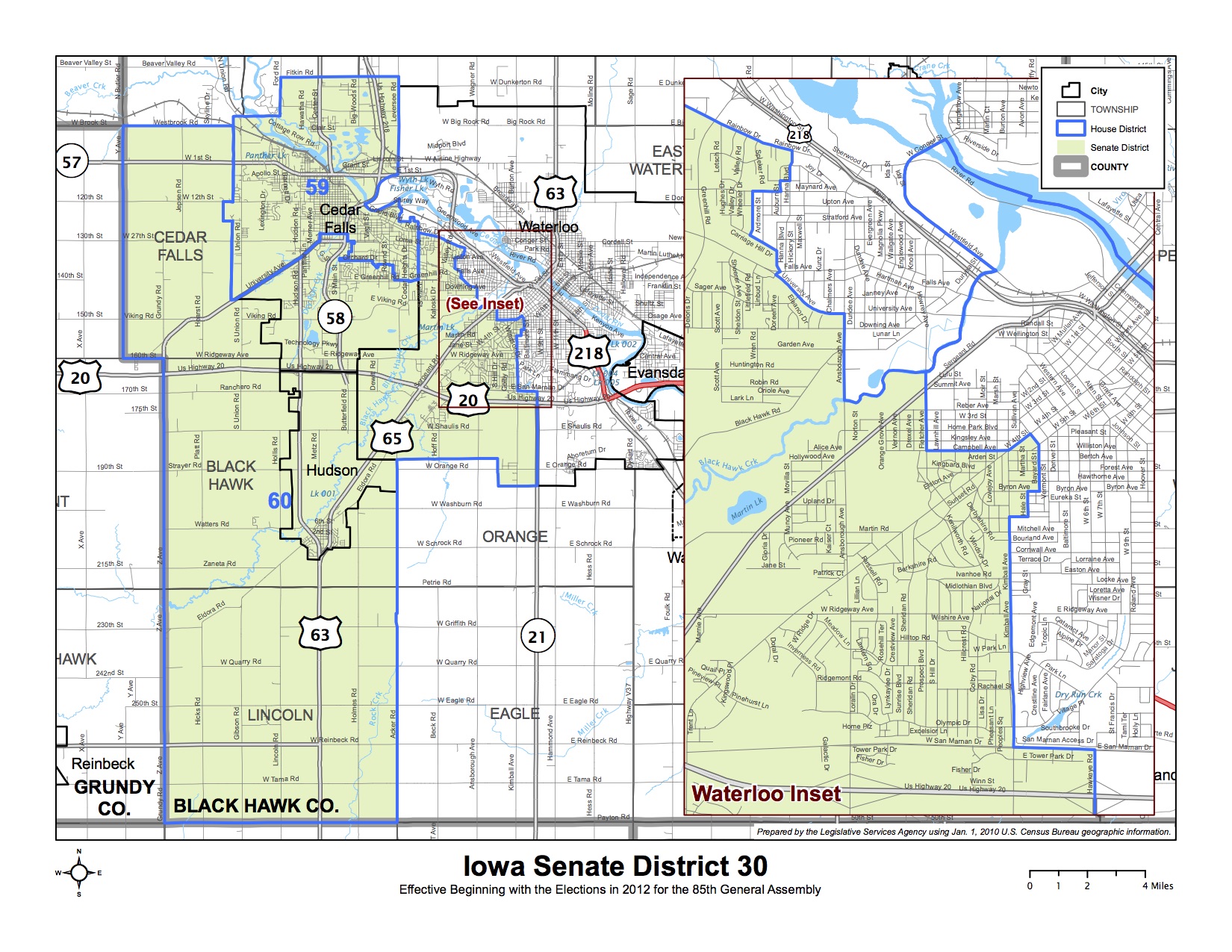Iowans will elect 25 state senators today. Those races have attracted far less attention than this year’s Iowa House races, because Republicans have a lopsided 32-18 majority in the upper chamber and only a 53-47 advantage in the House.
Nevertheless, it’s important to keep an eye on the Senate races, because this year’s outcome will influence Democratic prospects under the new map coming in 2021.
This overview covers five districts where both parties are spending six-figure amounts, seven districts where Republicans spent a significant amount, and four more districts where the results could shed light on political trends in various parts of the state, even though neither Democrats nor Republicans targeted the race.
All voter registration totals listed below come from the Iowa Secretary of State’s office, as reported on November 2.
All absentee ballot request totals come from the Secretary of State’s office, as reported on November 2.
Data on voting for president in 2016 and for governor in 2018 in each Senate district come from this spreadsheet compiled by the Daily Kos Elections team.
Campaign spending figures come from reports posted on the Iowa Ethics and Campaign Disclosure Board’s website for October 19 and the Friday before the general election. I am focusing on in-kind spending, because the state parties do most of the spending in competitive Iowa House or Senate races. That money is largely reported as in-kind contributions rather than direct spending by legislative campaigns.
BIG PICTURE: REPUBLICAN MAJORITY MAY SHRINK
While Democrats have a realistic chance to win a majority of Iowa House seats this year, GOP control of the upper chamber is not seriously threatened. Only half of the 50 seats are on the ballot each election–even-numbered districts in presidential years, odd-numbered districts in midterms. It would be extremely difficult to pick up eight seats in one election cycle. In addition, Republican Senate leaders have raised much more money than their Democratic counterparts.
That said, Democrats should be able to make up some ground in the Senate. Doing so will be essential to set the party up for 2022, when a new political map should create more opportunities. Almost all of the Iowa counties that have gained population since the 2010 census have trended toward Democrats in recent years.
The 2016 election was so disastrous that Democrats now hold only one state Senate seat they have a realistic chance to lose. In contrast, the GOP is at risk of losing several of the 32 seats they now hold.
A net gain of four Senate seats would reflect a good night for Democrats. Anything more than that would indicate a Democratic wave election. In contrast, picking up just one or two seats this year would be a disappointing result, leaving a big mountain to climb even under a more favorable 2022 map.
Only five races are seeing heavy spending by both parties.
TOP DEMOCRATIC TARGETS
Senate district 8
Bleeding Heartland profiled this race in more detail last year. This district, covering most of Council Bluffs and all of Carter Lake, is currently Iowa’s most evenly divided state Senate district in terms of voter registrations. Steve Gorman nearly pulled off an upset two years ago in House district 16–a race that’s now targeted by both parties largely due to his efforts. He’s been working hard this year, but the COVID-19 pandemic has limited his ability to speak to voters face to face. (Gorman knocked thousands of doors during the last campaign.)
Senator Dan Dawson defeated longtime Democratic Senate Majority Leader Mike Gronstal by 8 points in 2016; total spending in that race surpassed $1 million. While Dawson now has the advantages of incumbency, sitting lawmakers are often most vulnerable in their first re-election bids. Both parties have been spending heavily; the Omaha television market is the most expensive in Iowa.
Rating: toss-up
Current active registered voter totals: 11,661 Democrats, 11,631 Republicans, 11,790 no-party voters
Absentee ballots received by county auditor: 6,474 Democrats, 5,063 Republicans, 3,026 no-party voters
In-kind spending by Democrats: $214,078.64 on October 19 report, $263,494.69 on October 30 report
In-kind spending by Republicans: $298,301.36 on October 19 report, $226,270.75 on October 30 report
2016 voting for president: Trump 51.6 percent, Clinton 41.9 percent
2018 voting for governor: Republican Kim Reynolds 48.9 percent, Democrat Fred Hubbell 47.9 percent
Senate district 20
This district and the next one are ground zero for political change in the Iowa suburbs. Senator Brad Zaun was unopposed in his 2008 and 2012 re-election bids, and although he had a Democratic challenger in 2016, neither party invested in the race.
A lot has changed since then. Going into the 2016 general election, Senate district 20 had about 4,000 more registered Republicans than Democrats. Now Democrats have the edge by nearly 1,000. The number of no-party voters has changed little in the same time span.
Since Bleeding Heartland first covered this match-up in May 2019, Johnston City Council member Rhonda Martin has clearly spooked Zaun. His campaign literature emphasized his supposedly “independent voice” and support for education and mental health care. Internal Republican polling must show serious problems for Zaun among women, because the senator’s final tv ad was a testimonial from his wife DeDe Zaun, who says he “fought to stop animal cruelty and led the fight for mental health funding in Iowa.”
Democrats have been running positive television and radio ads for Martin, as well as a negative spot highlighting Zaun’s proposal to require a 72-hour waiting period for all abortions. (Questioned early this year, Zaun did not rule out applying the requirement to women who had miscarriages.)
Democrats have an impressive GOTV operation in Urbandale and Johnston, and Donald Trump will likely be a drag on Zaun, who was the first Iowa lawmaker to endorse his presidential bid in 2015.
Then again, it’s hard to beat an entrenched incumbent. Zaun’s served in the legislature for sixteen years and was mayor of Urbandale for several years before that.
Rating: tilt Democratic
Current active registered voter totals: 18,437 Democrats, 17,527 Republicans, 14,531 no-party voters
Absentee ballots received by county auditor: 12,115 Democrats, 6,581 Republicans, 4,984 no-party voters
In-kind spending by Democrats: $270,398.84 on October 19 report, $209,648.80 on October 30 report
In-kind spending by Republicans: $288,339.41 on October 19 report, $191,933.75 on October 30 report
2016 voting for president: Trump 46.4 percent, Clinton 46.8 percent
2018 voting for governor: Reynolds 47.2 percent, Hubbell 51.1 percent
Senate district 22
This Romney/Clinton district in the western suburbs of Des Moines has swung even more dramatically than neighboring Senate district 20. Going into the 2016 presidential election, Republicans outnumbered Democrats here by more than 4,000. Now Democrats have an advantage of 2,000 registered voters. When Democrats Jennifer Konfrst and Kenan Judge flipped the two Iowa House seats that make up this Senate district in 2018, and Fred Hubbell carried the district by 8 points in the governor’s race, it became clear that GOP State Senator Charles Schneider would be a top Democratic target this year.
Schneider opted to retire rather than fight to continue as Senate president, the second-ranking position in GOP leadership. Republicans recruited a strong replacement candidate in longtime Clive Mayor Scott Cirksena, who is fairly well-known and can’t be blamed directly for the excesses of the GOP trifecta. But the party reduced its spending here late in the campaign, which often signals they believe a cause is lost.
Sarah Trone Garriott, an ordained Lutheran pastor who works for the non-profit Des Moines Area Religious Council, won a three-way primary in which all candidates were working hard, and Democrats have outspent Republicans on television advertising. Given recent political trends among suburban women, Hubbell’s performance in the governor’s race, and strong early vote numbers, Trone Garriott has to be considered the favorite.
Rating: lean Democratic
Current active registered voter totals: 20,314 Democrats, 18,299 Republicans, 16,283 no-party voters
Absentee ballots received by county auditor: 14,318 Democrats, 8,799 Republicans, 6,186 no-party voters
In-kind spending by Democrats: $191,207.29 on October 19 report, $162,145.92 on October 30 report
In-kind spending by Republicans: $177,938,36 on October 19 report, $52,446.29 on October 30 report
2016 voting for president: Trump 44.8 percent, Clinton 48.3 percent
2018 voting for governor: Reynolds 45.2 percent, Hubbell 53.4 percent
Senate district 44
This was the upset no one saw coming in 2016. I was worried about a wave for Trump endangering Democratic Senator Rich Taylor just south of here in Senate district 42, but Senator Tom Courtney seemed safe. He’d won his third term in 2012 by more than 4,000 votes.
Nevertheless, pharmacist Thomas Greene rode Trump’s coat-tails to beat Courtney by more than 1,400 votes. Greene opted to retire this year, and former Iowa House candidate Tim Goodwin easily won a GOP primary. Courtney defeated two rivals for the Democratic nomination.
I considered rating this race a toss-up, but recent Democratic performance has been a little better here than in Senate district 42, and Courtney is well-known in the area.
Rating: tilt Democratic
Current active registered voter totals: 14,247 Democrats, 12,294 Republicans, 12,986 no-party voters
Absentee ballots received by county auditor: 8,086 Democrats, 5,417 Republicans, 3,367 no-party voters
In-kind spending by Democrats: $152,573.07 on October 19 report, $207,068.31 on October 30 report
In-kind spending by Republicans: $228,965.90 on October 19 report, $153,790.14 on October 30 report
2016 voting for president: Trump 52.4 percent, Clinton 42.0 percent
2018 voting for governor: Reynolds 48.1 percent, Hubbell 50.0 percent
SOLE REPUBLICAN TARGET
Having swept all of the heavily contested Iowa Senate races in 2016, plus Senate district 44, Republicans don’t have many good prospects for offense this cycle. They didn’t even recruit a challenger to run against State Senator Liz Mathis in Senate district 34, covering much of the Cedar Rapids suburbs.
There is one Democratic-held seat the GOP is trying to win.
Senate district 42
I never did get the backstory on why then Senate Republican Leader Bill Dix didn’t spend money on this race in 2016. The potential for a pickup was there. With hindsight, it’s obvious the GOP could have won a seventh Democratic-held seat with a modest investment. Instead, Senator Rich Taylor was re-elected by fewer than 200 votes.
In terms of voter registrations, this district is almost as evenly divided as Senate district 8. Its voters are somewhat hard to reach, as Lee County is part of the Quincy, Illinois television market, while Henry County is part of the Quad Cities viewing area. The small portions of Washington and Jefferson counties that are in Senate district 42 are in the Cedar Rapids and Ottumwa tv markets, respectively.
Taylor has strong backing from organized labor and passionately opposes the 2017 law stripping public employees of collective bargaining rights. He’s among the more moderate members of the Senate Democratic caucus and endorsed Amy Klobuchar for president before the 2020 Iowa caucuses.
Since Republicans won the trifecta, Taylor has crossed party lines more often than most of his Democratic colleagues. For example, he voted for a wide-ranging Republican bill to relax gun regulations and two versions of so-called “ag gag” legislation. Taylor also voted “present” (twice) on immigration bills Republicans claimed would address “sanctuary cities.”
GOP challenger Jeff Reichman grew up in Keokuk and was the Republican challenger in House district 83 during the last election cycle. Although he supports extreme abortion bans, he is largely campaigning on talking points about economic development, education, and health care. Reichman served in the Marine Corps for 27 years and highlighted that experience in his television commercials. (Taylor is also a veteran, with seven years of National Guard service early in his career.)
Republicans are running attack ads on Taylor, and residents of Senate district 42 voted heavily for Trump in the last presidential election after favoring Barack Obama in 2012. I don’t expect Joe Biden to perform as poorly among white working-class voters as Clinton did, but Taylor will likely need quite a few ticket-splitters to be re-elected. Hence the toss-up rating, despite the incumbency advantages that favor the Democrat.
Rating: toss-up
Current active registered voter totals: 11,987 Democrats, 12,605 Republicans, 12,367 no-party voters
Absentee ballots received by county auditor: 7,121 Democrats, 6,147 Republicans, 3,115 no-party voters
In-kind spending by Democrats: $136,550.58 on October 19 report, $191,212.49 on October 30 report
In-kind spending by Republicans: $178,749.47 on October 19 report, $188,531.06 on October 30 report
2016 voting for president: Trump 58.5 percent, Clinton 35.3 percent
2018 voting for governor: Reynolds 52.4 percent, Hubbell 45.5 percent
SECOND-TIER DEMOCRATIC TARGETS
A win in any of these seats would be a big upset. That said, Republicans were concerned enough to spend six figures defending each of these districts.
Senate district 28
Bleeding Heartland profiled this district last year, before two-term GOP Senator Michael Breitbach decided to retire. Breitbach had barely won an open-seat race in 2012, then was re-elected easily in 2016.
An open seat is usually a more promising target for the party out of power, but internal polling presumably didn’t show strong prospects for Democrats here. The party has spent relatively little on behalf of its candidate Matt Tapscott. Meanwhile, Republicans put more than $170,000 behind Spillville Mayor Mike Klimesh, an unsuccessful candidate for the state House in 2010 and 2012. GOP performance has markedly improved in northeast Iowa since then.
While an win for Tapscott is unlikely, I’ll be interested to see whether he and Democrats higher up on the ballot improve on 2016. Many older white Catholics live in this part of the state, and Biden should be more appealing to those voters than Clinton was.
Rating: likely Republican
Current active registered voter totals: 11,609 Democrats, 14,972 Republicans, 12,743 no-party voters
Absentee ballots received by county auditor: 7,668 Democrats, 7,395 Republicans, 4,213 no-party voters
In-kind spending by Democrats: $43,513.87 on October 19 report, $12,294.80 on October 30 report
In-kind spending by Republicans: $107,001.06 on October 19 report, $63,096.61 on October 30 report
2016 voting for president: Trump 55.0 percent, Clinton 39.4 percent
2018 voting for governor: Reynolds 54.4 percent, Hubbell 41.9 percent
Senate district 32
Bleeding Heartland previewed Pam Egli’s challenge against State Senator Craig Johnson last October. This part of northeast Iowa used to be heavily populated by “Kennedy Democrats” but swung hard to Republicans during the past decade.
Republicans spent more than $575,000 on this race in 2016, when Johnson rode the Trump wave in northeast Iowa to defeat a well-liked and hardworking incumbent by nearly 20 points.
Although Democrats are spending only a modest amount of money here, the GOP has spent nearly $300,000 to protect Johnson’s seat. Maybe they saw signs of trouble in their polling, or covered their bases because a plurality of registered voters in Senate district 32 are independents. Both parties are targeting House district 64, an open Democratic-held seat that makes up half of this Senate district.
Rating: likely Republican
Current active registered voter totals: 11,443 Democrats, 12,859 Republicans, 16,026 no-party voters
Absentee ballots received by county auditor: 7,300 Democrats, 5,629 Republicans, 4,591 no-party voters
In-kind spending by Democrats: $51,511.09 on October 19 report, $14,167.50 on October 30 report
In-kind spending by Republicans: $243,586.36 on October 19 report, $55,078.75 on October 30 report
2016 voting for president: Trump 54.3 percent, Clinton 39.6 percent
2018 voting for governor: Reynolds 53.6 percent, Hubbell 44.0 percent
Senate district 46
This contest is the only Iowa Senate rematch from 2016. Bleeding Heartland profiled the candidates and their prospects last year, when former Democratic Senator Chris Brase began campaigning against Senator Mark Lofgren. Brase had defeated a GOP incumbent in 2012, when Obama carried this district by 12 points. Voters favored Trump by 8 points four years later, which boosted Lofgren.
Senate district 46 was among the most expensive Iowa legislative campaigns of 2016, with Democrats and Republicans each spending more than half a million dollars. This year’s campaign is less costly, suggesting internal polling doesn’t show Lofgren is endangered.
Both halves of the district are battleground state House races (districts 91 and 92), where the parties have spent hundreds of thousands of dollars over the past two months.
Rating: likely Republican
Current active registered voter totals: 12,959 Democrats, 13,164 Republicans, 15,195 no-party voters
Absentee ballots received by county auditor: 7,882 Democrats, 6,618 Republicans, 4,920 no-party voters
In-kind spending by Democrats: $63,871.01 on October 19 report, $8,722.74 on October 30 report
In-kind spending by Republicans: $169,736.36 on October 19 report, $69,890.38 on October 30 report
2016 voting for president: Trump 50.8 percent, Clinton 42.9 percent
2018 voting for governor: Reynolds 51.6 percent, Hubbell 46.3 percent
THIRD-TIER DEMOCRATIC TARGETS
The GOP spending in all of these races looks like overkill. On the other hand, Courtney lost in 2016 because Democrats didn’t recognize the political headwinds in southeast Iowa. So maybe Republicans saw something scary in their statewide polling this fall and decided not to take for granted any district Obama had carried in 2012.
Senate district 24
Outgoing incumbent Jerry Behn is currently the longest-serving Iowa Senate Republican and hasn’t faced a tough re-election campaign in many years. Voters in Senate district 24 narrowly favored Obama in 2012 but preferred Trump to Clinton by nearly 20 points.
Four Republicans including the senator’s son competed for the GOP nomination after Behn announced his retirement early this year. Jesse Green won that primary, and Cynthia Paschen defeated Behn’s 2016 challenger Keith Puntenney for the Democratic nomination.
Republicans have spent nearly $100,000 on Green’s behalf, despite a lack of investment on the Democratic side.
Rating: safe Republican
Current active registered voter totals: 12,078 Democrats, 16,441 Republicans, 13,806 no-party voters
Absentee ballots received by county auditor: 7,994 Democrats, 7,572 Republicans, 3,872 no-party voters
In-kind spending by Democrats: nothing
In-kind spending by Republicans: $61,763.36 on October 19 report, $34,677.44 on October 30 report
2016 voting for president: Trump 56.0 percent, Clinton 37.4 percent
2018 voting for governor: Reynolds 53.8 percent, Hubbell 44.0 percent
Senate district 26
Democrats failed to recruit a candidate for this year’s primary, which wasn’t surprising. This area includes the Iowa counties that registered the largest swing from Obama 2012 to Trump 2016. The last time Senate district 26 was on the ballot, Republican challenger Waylon Brown defeated a two-term incumbent by nearly 25 points.
Bleeding Heartland profiled this race soon after Deb Scharper announced her candidacy in April.
The parties’ combined spending in this district topped $800,000 in 2016, and some outside groups targeted the race as well. This year, it’s a low-key affair.
Rating: safe Republican
Current active registered voter totals: 10,985 Democrats, 13,412 Republicans, 15,439 no-party voters
Absentee ballots received by county auditor: 6,875 Democrats, 6,071 Republicans, 4,371 no-party voters
In-kind spending by Democrats: nothing
In-kind spending by Republicans: $39,134.06 on October 19 report, $13,948.97 on October 30 report
2016 voting for president: Trump 57.8 percent, Clinton 36.7 percent
2018 voting for governor: Reynolds 57.0 percent, Hubbell 40.4 percent
Senate district 36
Here’s another district that was highly competitive in 2016, with more than $850,000 in in-kind spending from the parties. When Dave Degner announced his candidacy last summer, I thought this Obama/Trump district could become a 2020 battleground as well. But Democrats must not have seen an opening here. Republicans spent six figures supporting Edler anyway.
Rating: Safe Republican
Current active registered voter totals: 10,970 Democrats, 11,735 Republicans, 14,325 no-party voters
Absentee ballots received by county auditor: 6,854 Democrats, 5,486 Republicans, 2,988 no-party voters
In-kind spending by Democrats: nothing
In-kind spending by Republicans: $110,578.35 on October 19 report, $17,929.98 on October 30 report
2016 voting for president: Trump 53.8 percent, Clinton 40.8 percent
2018 voting for governor: Reynolds 51.3 percent, Hubbell 46.6 percent
Senate district 38
Democrats hadn’t targeted GOP State Senator Tim Kapucian in 2012 or 2016, but an open seat can be more difficult to defend. So when Kapucian retired in a district Obama had carried in 2012 by a little more than 1 percent, Republicans left nothing to chance.
Dawn Driscoll had won a three-way GOP primary with about 45 percent of the vote, while Ivy Schuster dominated the Democratic primary and raised a lot of money for a first-time legislative candidate (more than $65,000 at this writing). Even so, I was stunned to see that Republicans spent more than $215,000 on this race. You have to wonder what they saw in their internal polling.
Rating: Likely Republican
Current active registered voter totals: 11,768 Democrats, 15,197 Republicans, 15,652 no-party voters
Absentee ballots received by county auditor: 6,995 Democrats, 6,334 Republicans, 4,213 no-party voters
In-kind spending by Democrats: $31,828.94 on October 19 report, nothing from Iowa Democratic Party on October 30 report (county Democratic committees chipped in $479)
In-kind spending by Republicans: $192,018.05 on October 19 report, $23,810.22 on October 30
2016 voting for president: Trump 57.0 percent, Clinton 37.4 percent
2018 voting for governor: Reynolds 56.2 percent, Hubbell 41.5 percent
NON-TARGETED RACES WORTH WATCHING
Though the political terrain of these districts makes a flip extremely unlikely, the results should be interesting.
Senate district 6
Democrats didn’t field a candidate in this northwest Iowa district in 2016. It’s an open seat now due to Mark Segebart’s retirement. Craig Williams won the GOP primary and is heavily favored for obvious reasons.
C.J. Petersen, a former Republican who has described himself as “just your average gay, deaf, small-town Iowan— running for Mr. [Steve] King’s old State Senate seat,” has been working very hard. You can read about Petersen’s political evolution and approach to campaigning as a “dirt road Democrat” in this Bleeding Heartland commentary he wrote in August.
What is the baseline for Democrats in an area that hasn’t seen a competitive state Senate race in a long time and includes one of Iowa’s most diverse counties (Buena Vista) as well as Carroll and Audubon, where Democrats did well before the 2000s? We’ll soon find out.
Rating: Safe Republican
Current active registered voter totals: 9,659 Democrats, 16,053 Republicans, 13,493 no-party voters
Absentee ballots received by county auditor: 5,387 Democrats, 6,931 Republicans, 3,412 no-party voters
In-kind spending by Democrats: $9,712.64 on October 19 report, nothing on October 30 report
In-kind spending by Republicans: nothing
2016 voting for president: Trump 64.4 percent, Clinton 30.9 percent
2018 voting for governor: Reynolds 62.7 percent, Hubbell 35.4 percent
Senate district 10
Bleeding Heartland profiled this race in January. Democrats did not field a candidate against State Senator Jake Chapman in 2012 and did not spend money on behalf of Chapman’s 2016 challenger. The published results from 2016 are not entirely accurate, because the incompetent Dallas County auditor failed to count 5,842 early votes. But it’s clear Chapman won by a comfortable margin (67 percent of votes counted to 33 percent for the Democrat).
This year, Warren Varley has been running an active campaign despite the challenges posed by COVID-19. Chapman isn’t worried; he transferred $299,000 (most of what he raised) to the Republican Party of Iowa for use in other districts. Chapman pulls in larger contributions than most legislators, because he chairs the powerful Senate Ways and Means Committee.
The Dallas County suburbs have been trending toward Democrats, but only a small portion of that area is part of Senate district 10. I’m closely watching the results here to see how much a hard-working candidate can lift the baseline for Democrats, and because Dallas County will certainly get an additional Senate district when Iowa draws a new map next year.
Rating: Safe Republican
Current active registered voter totals: 12,668 Democrats, 18,979 Republicans, 17,038 no-party voters
Absentee ballots received by county auditor: 8,166 Democrats, 8,217 Republicans, 4,839 no-party voters
In-kind spending by Democrats: $29,739.32 on October 19 report, $1,000 on October 30 report
In-kind spending by Republicans: nothing
2016 voting for president: Trump 57.7 percent, Clinton 36.1 percent
2018 voting for governor: Reynolds 56.8 percent, Hubbell 41.1 percent
Senate district 12
Joni Ernst represented this southwest Iowa district before she was elected to the U.S. Senate in 2014. Mark Costello won the special election to serve the remainder of that term, and when he was up for re-election four years ago, his only opponent was a Libertarian.
Joey Norris took on the challenge of running in this huge district, where there are more than 4,000 more Republicans than the combined total of Democrats and no-party voters. The GOP needs large margins in these counties to boost their statewide candidates and David Young in the third Congressional district.
Rating: Safe Republican
Current active registered voter totals: 7,414 Democrats, 21,416 Republicans, 9,938 no-party voters
Absentee ballots received by county auditor: 4,291 Democrats, 9,561 Republicans, 2,329 no-party voters
In-kind spending by Democrats: nothing
In-kind spending by Republicans: nothing
2016 voting for president: Trump 68.3 percent, Clinton 26.6 percent
2018 voting for governor: Reynolds 64.8 percent, Hubbell 32.9 percent
Senate district 30
This district covering Cedar Falls and part of Waterloo was among the top targets for Republicans in 2012. But they didn’t invest much in trying to defeat State Senator Jeff Danielson in 2016.
However, Danielson’s retirement in the middle of the 2019 legislative session created an opening. Walt Rogers had just lost a close race in Iowa House district 60 after representing that half of the Senate district for eight years. The GOP poured $96,000 into the March 2019 special election, airing ridiculous attack ads about Democratic candidate Eric Giddens. But Giddens won that race by double digits.
Republicans haven’t thrown much money toward Giddens’ current opponent, Harold Youngblut.
Rating: Safe Democratic
Current active registered voter totals: 15,415 Democrats, 13,116 Republicans, 12,987 no-party voters
Absentee ballots received by county auditor: 10,581 Democrats, 6,662 Republicans, 4,565 no-party voters
In-kind spending by Democrats: $38,098.03 on October 19 report, $1,000 on October 30 report
In-kind spending by Republicans: $7,137 on October 19 report, nothing on October 30 report
2016 voting for president: Trump 45.0 percent, Clinton 48.4 percent
2018 voting for governor: Republican Kim Reynolds 44.5 percent, Democrat Fred Hubbell 53.4 percent
Top image: Iowa Senate chamber, as photographed by Madeleine Openshaw.

